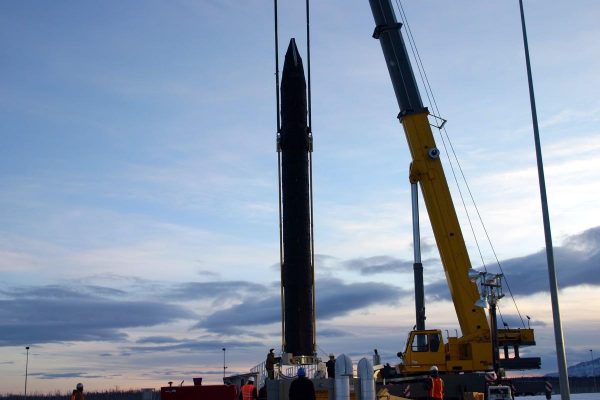
The Pentagon’s decision last week to cancel a billion-dollar contract held by Boeing Co., due to problems with the “kill vehicle” payload on interceptor missiles like those at Fort Greely, won’t affect the expansion project under way at the Army post’s missile-defense base.
Pentagon officials say they canceled Boeing’s $1.2 billion contract because of ongoing problems with the so-called “kill vehicle” that sits atop the interceptor missiles. Officials with the Raytheon Co., which builds the component, reportedly say they’ve struggled to correct design and manufacturing problems that have increased the kill vehicle program’s costs.
But Missile Defense Agency spokesperson Mark Wright says that decision won’t stop expansion work under way at the missile base on Fort Greely.
“The work of adding the 20 new silos at Missile Field 4 at Fort Greely is underway now,” he said Wednesday. “We’re making good progress. And that will continue – that absolutely will continue, until completion.”
Wright says the interceptors to be emplaced in the 20 new silos won’t come with the Redesigned Kill Vehicles, or RKVs, that are intended to collide with an incoming enemy missile as it enters the Earth’s atmosphere en route to its target.
“With the RKV (program) cancellation, we will no longer put in the ground the interceptors topped with RKV warheads,” he said.
Wright says instead that the new interceptors and eventually the 40 others at Greely all will be equipped with a next-generation kill vehicle that the Pentagon and its contractors will develop. But he says it’ll take a while.
“That’s all something that we have to develop – figure out with industry what’s technically feasible, what’s not feasible, etc,” Wright said.
Because of all that, Wright says there’s no estimate yet on how long it’ll take for the new kill vehicle to be developed – and when it will be deployed.
“We’re at the outset of developing and procuring the next-generation interceptor,” he said, “so we don’t have a timeline yet,” he said.
The RKV is the second-generation kill vehicle that replaced the problem-plagued first-generation EKV, or Exoatmospheric Kill Vehicle. The RKV had more success than the EKV at knocking down incoming missiles – a technological feat that’s been compared with shooting a bullet out of the sky with another bullet.
The kill vehicles, like the overall Ground-based Midcourse Defense program they’re part of, have met only partial success in overcoming that challenge, as the interceptors have destroyed just over half of the dummy ICBMs they’ve targeted in tests.
That’s why one Fairbanks-based observer says a midcourse correction to the $200 million Missile Field 4 expansion is a good idea, whether or not it slowed the expansion project at Greely.
“If we’re going to have a missile-defense field, we want it to be effective,” said Jim Dodson, the president and CEO of the Fairbanks Economic Development Corporation. He says it’s clear a better kill vehicle is needed to counter both conventional nuclear-tipped missiles and more advanced weapons like those being developed by adversaries.
“I think the military has determined that the (kill) vehicle is not effective, particularly against emerging technologies from North Korea and Russia and China,” Dodson said. “So, certainly, you can’t categorize that move as bad news.”
Boeing was awarded the RKV program contract in May 2017, and the Pentagon put in on pause two years later before finally deciding to pull the plug last week. But the aerospace giant remains a major Ground-based Missile Defense system contractor.
GMD is one of several U.S. missile-defense programs The Pentagon reportedly has spent about $180 billion on the GMD program since is it was begun in 2002.
Tim Ellis is a reporter at KUAC in Fairbanks.




